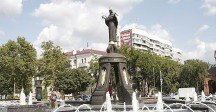Map of Nizhny Novgorod
Detailed interactive map of Nizhny Novgorod. Map of Nizhny Novgorod with streets and numbers of houses. Satellite map of Nizhny Novgorod with sights of the city.
The change between the satellite map of Nizhny Novgorod and the schematic one is made in the lower left corner of the interactive map.
Nizhny Novgorod
The population of Nizhny Novgorod: 1,244,254 people (2021)
Date of foundation of Nizhny Novgorod: 1221.
Nizhny Novgorod city phone code: +7 831
Automobile area code of Nizhny Novgorod: 52, 152
Postal code of Nizhny Novgorod: 603xxx
Nizhny Novgorod Airport: Strigino (GOJ)
Nizhny Novgorod is a million–strong city in Russia, which is located in the Volga region, being the largest city in this part of the country. Nizhny Novgorod (formerly Gorky) is a city and the administrative center of the Nizhny Novgorod Region. The city is located at the confluence of the Volga and Oka rivers, 420 km away east of Moscow.
The history of Nizhny Novgorod
Although some sources indicate an earlier date, the city was founded according to the main chronicle in 1221 by Yuri Vsevolodovich, Prince of Vladimir. Nizhny Novgorod's strategic location ensured its location on the Great Volga Route from the Baltic States to Central Asia - with connections through the navigable Oka River with the Vladimir-Moscow Region and through the Kama River with the Ural Mountains.
In 1392 Nizhny Novgorod was incorporated into the Moscow Principality. From there, Ivan III the Great in 1469 and Ivan IV the Terrible in 1552 began their campaigns against the Tatar capital Kazan. The conquest of the Volga in the middle of the 16th century led to an increase in trade with Nizhny Novgorod.
The annual fair, organized in this city in 1817, has become the largest and most important in Russia, attracting merchants and goods from all over Europe and Asia. The fair continued until the Russian Revolution of 1917. The famous writer Maxim Gorky was born in Nizhny Novgorod in 1868, and in 1932 the city was renamed in his honor, although its original name was restored in 1990.
The large volume of trade that passed through the city led to an earlier start of factory industrialization than in most of Russia, especially in heavy industry and mechanical engineering. The industrial importance of the city grew steadily, stimulated in the First and Second World Wars by the destruction of factories in the West.
Nizhny Novgorod City
Modern Nizhny Novgorod is one of the largest cities in Russia and the center of a large metropolis that stretches along the Volga and the lower Oka. The city is home to the Gorky Automobile Plant (GAZ), one of the largest in Russia, and also produces many types of ships and river vessels, diesel engines, machines and machine tools, as well as a wide range of chemical and household appliances.
From its satellite cities, Bor, across the Volga, makes glass, in particular safety glass for cars. Dzerzhinsk produces chemicals and fertilizers, Balakhna and Pravdinsk produce paper, Bogorodsk produces leather goods and shoes, and Kstovo has a large oil refinery.
Electricity for the megalopolis comes from two thermal power plants in Nizhny Novgorod - the Balakhninskaya peat plant and a hydroelectric power plant in the Volga region. In the post-Soviet period, the city retained its industrial profile, and at the beginning of the 21st century, of the country's cities with a population of more than a million people, it had the highest proportion of the working population employed in industry.
Transport in Nizhny Novgorod
Nizhny Novgorod is the center of excellent communication by rivers, roads, railways and air routes. Railways connect it with Moscow, Kirov (on the Trans-Siberian Railway) and Arzamas, and electrified suburban lines serve the metropolitan region.
Nizhny Novgorod has many higher educational institutions, including the Lobachevsky State University (founded in 1918). The State Art Museum and one of the oldest drama theaters in Russia (founded in 1798) are also located here.
Nizhny Novgorod is the center of river tourism, because it stands at the confluence of two large rivers – the Volga and the Oka. But these are not the only water bodies in the city – there are more than 12 rivers and more than 30 lakes.
The number of historical and architectural monuments cannot but surprise, because there are about 600 of them in the city. Due to this, Nizhny Novgorod is one of hundreds of cities on the UNESCO list, and its main attraction is the medieval Kremlin of the 16th century, whose wall length is about two km. This grandiose structure includes 13 towers.
Sights of Nizhny Novgorod
Nizhny Novgorod Kremlin, Chkalovskaya Staircase, Nativity Church, Nizhny Novgorod Fair, Rukavishnikov Manor, State Bank Building, Nizhny Novgorod State Art Museum, Nizhny Novgorod Drama Theater, Bolshaya Pokrovskaya Street, Pechersk Monastery, Nizhny Novgorod Cable Car, Verkhne-Volzhskaya Embankment, Mikhailo-Arkhangelsk Cathedral, GAZ History Museum, Peter I House, Pechersk Voznesensky monastery, Victory Park, Nativity Church, St. Nicholas Cathedral, Alexander Garden, Nizhny Novgorod prison, Annunciation Monastery, Monument to Minin and Pozharsky.
The largest cities in Russia:
2024 © Russia-Karta.ru







